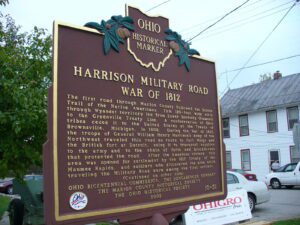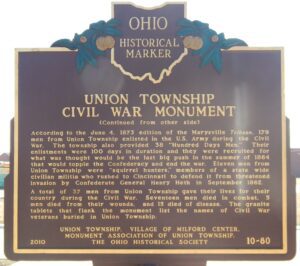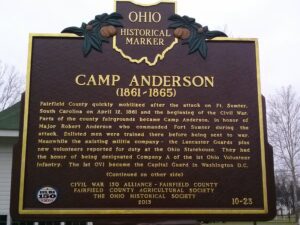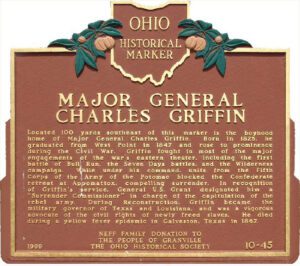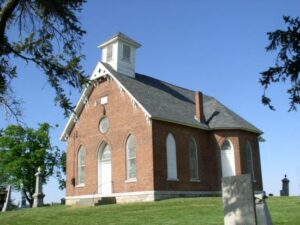, OH
The first road through Marion County followed the Scioto Trail of the Native Americans. This 120-foot wide strip through Wyandot territory led from Lower Sandusky (Fremont) to the Greenville Treaty Line. A confederation of Ohio tribes ceded it to the United States at the Treaty of Brownsville, Michigan, in 1808. During the War of 1812, the troops of General William Henry Harrison’s Army of the Northwest traveled this road en route to Fort Meigs and the British fort at Detroit, using it to transport supplies to the army and to the chain of forts and blockhouses that protected the road. After the American victory, this area was opened for settlement by the 1817 Treaty of the Maumee Rapids, and soldiers who discovered the area while traveling the Military Road were among the first settlers. (continued on other side)
, OH
The following notice appeared in the Marysville Tribune newspaper, February 5, 1873: To Arms! To Arms! The Monument Association of Union Township propose holding a Fair and Festival in Milford Centre on Feb 20 and 21…the proceeds to be applied to the fund already raised to erect a Monument in memory of the fallen heroes of Union Tp. Said Monument to be unveiled on the 30th of May, 1873. It is desired that every citizen have an opportunity to contribute something in aid of such a worthy object. It is therefore hoped that every person, male and female, will send in their donations of such articles as they may have to lay upon the alter of our departed Heroes. Bring Wheat, Corn, fancy work, mitts, Hoods, articles for children, anything, to the value of a horse…. On May 30, 2003—130 years later—the Monument Association of Union Township rededicated the refurbished monument.
, OH
Fairfield County quickly mobilized after the attack on Ft. Sumter, South Carolina on April 12, 1861 and the beginning of the Civil War. Parts of the county fairgrounds became Camp Anderson, in honor of Major Robert Anderson who commanded Fort Sumter during the attack. Enlisted men were trained there before being sent to war. Meanwhile the existing militia company- the Lancaster Guards plus new volunteers reported for duty at the Ohio Statehouse. They had the honor of being designated Company A of the 1st Ohio Volunteer Infantry. The 1st OVI became the Capital Guard in Washington D.C.
, OH
In 1918, Charles Young made a desperate attempt to convince the U.S. Army that he was fit for duty. The Army’s highest-ranking Black officer, he had been medically retired and not given a command during World War I. To demonstrate his fitness, he rode 497 miles from his home in Wilberforce, Ohio, to Washington, D.C. Leaving on June 6 he made the journey in 17 days, 16 on horseback and 1 resting. Averaging 31 miles each day, he rode 45 minutes and walked 15 minutes every hour. Upon his arrival, Young met with Secretary of War Newton Baker. Pressured by the Black press and the White House, Baker hedged. He recalled Young to active duty a year later and assigned him to Camp Grant, Illinois, just five days before the end of the war.
, OH
Located 100 yards southeast of this marker is the boyhood home of Major General Charles Griffin. Born in 1825, he graduated from West Point in 1847 and rose to prominence during the Civil War. Griffin fought in most of the major engagements of the war’s eastern theater, including the first battle of Bull Run, the Seven Days battles, and the Wilderness campaign. While under his command, units from the Fifth Corps of the Army of the Potomac blocked the Confederate retreat at Appomattox, compelling surrender. In recognition of Griffin’s service, General U.S. Grant designated him a “Surrender Commissioner” in charge of the capitulation of the rebel army. During Reconstruction, Griffin became the military governor of Texas and Louisiana, and was a vigorous advocate of the civil rights of newly freed slaves. He died during a yellow fever epidemic in Galveston, Texas in 1867.
, OH
The first Mt. Tabor Church, a log meetinghouse, was erected on this site in 1816. It stood on land originally selected by Griffith and Martha Evans for a graveyard at the death of their daughter circa 1812. Deeds show the Evans family gave two and one half acres of land “for the purpose of erecting a meetinghouse and establishing a burying site.” Camp meetings, religious gatherings popular in frontier Ohio, were held on the hillside west of the meetinghouse. Simon Kenton was converted at a Mt. Tabor camp meeting in 1819. The log meetinghouse burned in 1824 and was replaced with a brick church on the same spot. In 1881, the present brick church was completed and dedicated.
, OH
A descendent of Knox County’s earliest pioneers, Confederate Brigadier General Daniel Harris Reynolds was born just three miles west of Centerburg in 1832. He attended Ohio Wesleyan University in Delaware, where he became a close friend of Otho Strahl, another Ohio born Confederate general. Reynolds taught school in Ohio before studying law in Iowa and then Tennessee. Admitted to the bar in 1858, Reynolds established a law practice in Chicot County Arkansas. An advocate of secession, Reynolds chose to serve the Confederate States of America in his adopted state of Arkansas at the start of the Civil War. Well respected in his community, he raised a company of cavalry known as the “Chicot Rangers.” (Continued on other side)
, OH
In 1817, Revolutionary War veteran and Camden co-founder James Moore Sr. and his wife, Mary, deeded a plot to the trustees of the Methodist Episcopal Church (MEC) to erect a place of worship. Although a church was not built until 1825, the earliest burial stone recovered on the plot was that of five-year-old Simon P. Zimmerman, dated 1818. Many subsequently interred were victims of the cholera epidemic of 1849. Felix and Rachel Marsh, in 1852, sold an adjacent one-acre plot to the MEC trustees “for a graveyard.” The expanded cemetery became known as Orchard Hill Cemetery due to the nearby fruit orchards. Prominent citizens of early Camden as well as veterans of American conflicts from the Revolution through the Civil War are buried in the cemetery. (Continued on the other side)


